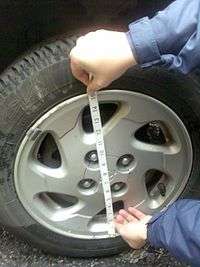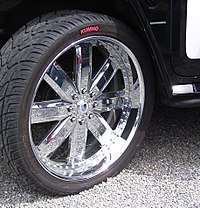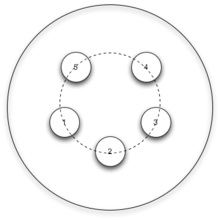Wheel sizing
The wheel size for a motor vehicle or similar wheel has a number of parameters.
Wheel size


The wheel size is the size designation of a wheel given by its diameter, width, and offset. The diameter of the wheel is given by measuring the distance from one side of the wheel to the other, through the center point of the wheel. The width is the distance measured from the bead seat to the other bead seat.The offset is the distance from the wheel's true centerline (half the width) to the wheel's mounting surface. Offset is covered in more detail further below. A typical wheel size will be listed beginning with the diameter (in inches), then the width (in inches), and lastly the offset (+ or - for positive or negative, respectively).
For example, 17x8.5 +35, the wheel's diameter is 17 inches, its width is 8.5 inches, and it has a +35 positive offset.
The most popular wheel size in the U.S. is the R15.[1] It is installed on 50% of U.S. passenger cars and light SUVs. The second most popular wheel size is R16.
Aftermarket wheels are typically chosen to give the vehicle a better performance level or offer a better appearance. Often, both of these are considered when purchasing new wheels.
Replacing the wheels on a car with larger ones can involve using tires with a smaller profile. This is done to keep the overall radius of the wheel/tire the same as stock to ensure the same clearances are achieved. Larger wheels are typically desired for their appearance but could also offer more space for brake components. This comes at a performance price though as larger wheels weigh more.
Alternatively, smaller wheels are chosen to fit a specific style of vehicle. An example of this is the Lowrider Culture in which smaller wheels are largely desired.
Wheel width is changed to allow for a wider tire to be used and to poke the wheel out to the fender of the vehicle. Having the ability to run a wider tire allows for more of the vehicle's power to be put to the ground because there is a larger surface area making contact with the road. This will improve a vehicle's performance when it comes to acceleration, handling, and braking.
Tire Sizes
Modern road tires have several measurements associated with their size as specified by tire codes like 225/70R14. The first number in the code (e.g., "225") represents the nominal tire width in millimeters. This is followed by the aspect ratio (e.g.,"70"), which is the height of the sidewall expressed as a percentage of the nominal tire width. "R" stands for radial and relates to the tire construction. The final number in the code (e.g.,"14") is the rim size measured in inches. The overall circumference of the tire will increase by increasing any of the tire's specifications. For example, increasing the width of the tire will also increase its circumference, because the sidewall height is a proportional length. Increasing the aspect ratio will increase the height of the tire and hence the circumference.
Off-roading tires may use a different measurement scheme: outside diameter times(by) tread width, followed by rim size (all in inches) – for example 31x10.50R15. The size of the disc, however, is denoted like 8.5" X 20.0". This means that the width (of thickness) of the wheel is 8.5 inches and the diameter is 20 inches.
Bolt pattern

_with_optional_parts.jpg)
The bolt pattern determines the number and position of the bolt holes on the wheel to line up with your vehicle's studs on the mounting hubs. The bolt holes are spaced evenly about the bolt hole circle. Bolt holes refers to the actual holes drilled into your wheel which is where your wheel studs come through. Wheel studs are the bolts that are on your mounting hub and are used along with lug nuts to attach the wheel to the car. The bolt hole circle is the circle that the center of each bolt aligns with. The second number in a bolt pattern is the diameter of this circle. All of these things come into play when describing the bolt pattern.[2]
The bolt circle is the notional circle that determines the position of the bolts. The center of every bolt lies along the outer edge of the bolt circle and, as stated above, are evenly spaced. The bolt circle has the same center point as the mounting hub to ensure that the wheel will be concentric with the mounting hub. The bolt circle's measurement is determined by the bolt circle diameter (BCD),[3] also called the pitch circle diameter (PCD).[4]
The bolt circle diameter is typically expressed in mm and accompanies the number of bolts in your vehicle's bolt pattern designation. One example of a common bolt pattern is 5x100. This means there are 5 bolts evenly spaced about a 100mm bolt circle.
The picture to the right is an example of a 5x100 bolt pattern on a Subaru BRZ. The wheel has 5 lug nuts and utilizes a 100mm bolt circle diameter.
Some of the most common BCD values are 100mm (≈3.94 inches), 112mm (4.41 inches) and 114.3mm (4.5 inches). These are used widely in modern vehicles and it is safe to assume that your vehicle's wheels utilize one of these BCDs. Always check your owner's manual or call your local car dealership to confirm the bolt pattern on your vehicle.
Lug nuts or bolts
Wheels must be fitted with the correct type of lug nuts on their corresponding wheel studs. Lug nuts will have either flat, tapered (conical), or ball (radius) seats. The type of seat a wheel requires will determine the appropriate lug nuts required to securely attach the wheel to the vehicle. A flat seat type has a flat end that screws down the wheel stud to put pressure on the wheel and compress it against the mounting hub. Similarly, tapered and ball seat types have a tapered or conical end and a semicircular end respectively. A place to find the lug nut type is to check OEM (Original Equipment Manufacturer) specifications if you have stock wheels or contact the seller if you have aftermarket wheels.[5]
Some aftermarket wheels will only fit smaller lug nuts, or not allow an ordinary lug nut to be properly torqued down because a socket will not fit into the lug hole. Tuner lug nuts were created to solve this problem by utilizing a special key to allow removal and installation with standard lug wrench or socket. The design of tuner lug nuts can range from bit style to multisided or spline drive, and are sometimes lightweight for performance purposes.
Another variation of lug nut is the "locking wheel nut", which is used as a theft prevention method to keep thieves from stealing a vehicle's wheels. When utilizing locking wheel nuts, one standard lug nut on each wheel is replaced with a nut that requires a unique key (typically a computer-designed, rounded star shape) to fit and remove the nut. This ensures that at least one lug nut will remain attached and, in theory, should prevent theft. However, universal removal tools are available which grip the head of the locking nut using a hardened left-hand thread. The success of locking wheel nuts depends on the determination of the would-be thief and the tools that they have available to them.
"Wheel Tech: Proper Lug Nuts or Lug Bolts". tirerack.com.
Offset
The offset is the distance from the hub-mounting surface to the wheel's true centerline. It is measured in mm and can be either positive or negative. A positive offset means the hub-mounting surface is closer to the outside edge of the wheel, while a negative offset means the hub-mounting surface is closer to the inside edge of the wheel.
A wheel with too little positive offset will be closer to edge of the fender. This can cause clearance issues between the tire and the fender. One that has too much positive offset will be closer to the suspension components and could cause the tire to rub on them. Wheel width, offset, and its accompanying tire size all determine how a particular wheel/tire combination will fit on a given vehicle. Offset also affects the scrub radius of the steering and it is advisable to stay within the limits allowed by the vehicle manufacturer. Because wheel offset changes the lever-arm length between the center of the tire and the centerline of the steering knuckle, the way bumps, road imperfections, and acceleration/braking forces turn into steering torques (bump-steer, torque-steer, etc.) and thus, will change the drivability of the vehicle depending on wheel offset. Likewise, the wheel bearings will see increased thrust loads if the wheel centerline is moved away from the bearing centerline.
When choosing an offset for an aftermarket wheel, it is important to take note of the space between the outer edge of the wheel and the fender. Depending on the desired style, you may want to match the change in offset from stock wheels to the amount of space between the wheel face and the fender. For example, if there is 15 mm of space between the outer face of the wheel and the fender and you're wanting a flush fitment, you would want to go from a +45 offset to a +30 offset. This will bring the mounting surface of the wheel further inward towards the vehicle from the true center point of the wheel thus poking the wheel out by an extra 15 mm. "Idiot's Guide to Wheel Fitment". drivingline.com.
Centerbore
The centerbore of a wheel is the size of the hole in the back of the wheel that centers it over the mounting hub of the car. Some factory wheels have a centerbore that matches exactly with the hub to reduce vibration by keeping the wheel centered. Wheels with the correct centerbore to the car they will be mounted on are known as hubcentric. Hubcentric wheels take the stress off the lug nuts, reducing the job of the lug nuts to center the wheel to the car. Wheels that are not hubcentric are known as lugcentric, as the job of centering is done by the lug nuts assuming they are properly torqued down. Another, more common, term here is hub piloted or stud piloted wheels and hubs. The stud piloted (lug centeric) is an older design while the hub piloted design in more commonly in use today and can provide for a stronger connection.
Centerbore on aftermarket wheels must be equal to or greater than that of the hub, otherwise the wheel cannot be mounted on the car. Many aftermarket wheels come with "hubcentric rings" that lock or slide into the back of the wheel to adapt a wheel with a larger centerbore to a smaller hub.[6] These adapters are usually made of plastic but also in aluminum. Plastic rings only provide initial centering, but are not strong enough to help support the wheel in case of high-speed pot hole hit. Steel ring is strongest, and aluminum is medium
X-factor
Caliper Clearance (X-factor): The amount of clearance built into the wheel to allow for the vehicle's disc brake and caliper assembly.
Load capacity
Load capacity is the amount of weight a wheel will carry. This number will vary depending on the number of lugs, the PCD, the material used and the type of axle the wheel is used on. A wheel used on a free rolling trailer axle will carry more weight than that same wheel used on the drive or steering axle of a vehicle. All wheels will have the load capacity stamped on the back of the wheel. GVWR is the Gross Vehicle Weight Rating. In the United States this information is required to be on the vehicle's door placard. The load capacity of the total number of wheels on the vehicle combined must meet or exceed the vehicle's GVWR.
Staggered wheel fitment
Staggered wheel fitment usually appears on the rear-wheel drive vehicles (and in smaller numbers some all wheel drive cars), when the rear wheels are wider than the front wheel.[7] Such wheel setup may be found on the Ford Mustang, Infiniti G35, certain models of Mercedes and BMW, etc. A good example of such wheel combination is having 19x8 in front and 19x9.5 in the rear. Technically, wider wheels in the rear allow better grip with the road surface which is a performance benefit for better acceleration. Another setup option of staggered wheel fitment is called double staggered, having smaller diameter narrow width wheels in the front with larger diameter and wider width wheel in the back. For example, a vehicle may feature 18x8 inch wheels in front and 19x10 inches in the rear. Such setups are found in the Chevrolet Corvettes, the first and second generation of the Acura NSX, and some others. Features of staggered wheel fitment:
- better grip with the road for improved acceleration;
- better cornering ability;
- the rear wheels cannot be rotated to the front and vice versa;
- the front and rear wheels will have different tire sizes;
- in case of improper installation the wheel may rub suspension or wheel arches.
See also
- Plus sizing
- Speedometer#Error - handy tire diameter formula, using tire code
- Tire code
- Uniform Tire Quality Grading (UTQG)
References
- "The Most Popular Tire Sizes: R15". Capitol Tires. April 2018.
- "Wheel Tech: Bolt Pattern". tirerack.com.
- "Bolt Circle Diameter (B.C.D.)". Sheldon Brown's Bicycle Glossary. Retrieved 3 Dec 2010.
- "P.C.D." Sheldon Brown's Bicycle Glossary. Retrieved 3 Dec 2010.
- "Wheel Tech: Proper Lug Nuts or Lug Bolts". tirerack.com.
- "Hubcentric-rings.com". Why hub centric rings?. Retrieved 21 Mar 2011.
- "Wheel and Tire Performance Handbook by Richard Newton p.50". Books.Google.com.